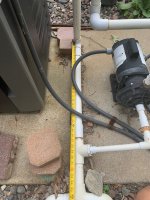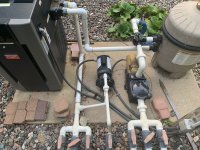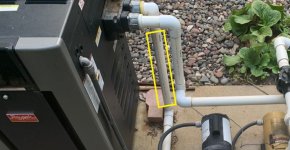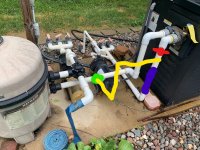Long time lurker, first time poster. I bought a house last Sept with an pool and was fortunate enough to have found this site while doing research before closing. I've been immensely grateful for all of the guidance which has kept me out of the pool store trap and keeping my pool trouble free (except for my fight with iron but that's another story).
I've decided to DIY install a SWG and after pouring through threads am still left with a couple of questions on which SWG to get and installation. Here are the facts thus far: I have a 14k gallon IG pool with a 1HP Hayward pump that is currently running 24/7 but I might reduce that since I'll be adding timers to manage the SWG.
With the size of my pool I have narrowed it down to either the CircuPool RJ-45 Plus (rated for 45k) or the AutoPilot ChlorSync CS40 (rated for 40k). With the current $10 upgrade deal at DSP I could get the RJ-45 for $1,385 and the CS40 for $1,281. I've read some rave reviews on the RJ-45 and I've seen posts from @RJ-45 with piles of controls boards that have been replaced which leaves me with mixed feelings on it. On the other hand I've read pretty much nothing about the CS40 or other ChlorSync models which makes wonder if there is a reason for this. I'm currently leaning towards the RJ-45 but if anyone has thoughts on the ChlorSync systems I'd be interested to hear about them.
With regards to installation I've got ~34 inches between the heater and the split for the returns but there is a currently a booster pump plumbed close to the return valves. Do I need to move the booster pump closer to the heater and install the SWG after the T for the booster pump? Or can I just leave the booster plumbing as is and put the SWG inline before it. I'm assuming I'll want to move it but figured I'd check.
Is there any advantages to placing the flow valve before or after the SWG? I think I could accomplish it in either configuration with the current setup but wasn't sure if one is preferable over the other.
I've attached pics of the setup below, let me know if there are any issues with my current plan that I might not be thinking of. Thanks for any help and insight.


I've decided to DIY install a SWG and after pouring through threads am still left with a couple of questions on which SWG to get and installation. Here are the facts thus far: I have a 14k gallon IG pool with a 1HP Hayward pump that is currently running 24/7 but I might reduce that since I'll be adding timers to manage the SWG.
With the size of my pool I have narrowed it down to either the CircuPool RJ-45 Plus (rated for 45k) or the AutoPilot ChlorSync CS40 (rated for 40k). With the current $10 upgrade deal at DSP I could get the RJ-45 for $1,385 and the CS40 for $1,281. I've read some rave reviews on the RJ-45 and I've seen posts from @RJ-45 with piles of controls boards that have been replaced which leaves me with mixed feelings on it. On the other hand I've read pretty much nothing about the CS40 or other ChlorSync models which makes wonder if there is a reason for this. I'm currently leaning towards the RJ-45 but if anyone has thoughts on the ChlorSync systems I'd be interested to hear about them.
With regards to installation I've got ~34 inches between the heater and the split for the returns but there is a currently a booster pump plumbed close to the return valves. Do I need to move the booster pump closer to the heater and install the SWG after the T for the booster pump? Or can I just leave the booster plumbing as is and put the SWG inline before it. I'm assuming I'll want to move it but figured I'd check.
Is there any advantages to placing the flow valve before or after the SWG? I think I could accomplish it in either configuration with the current setup but wasn't sure if one is preferable over the other.
I've attached pics of the setup below, let me know if there are any issues with my current plan that I might not be thinking of. Thanks for any help and insight.





